Our most popular topic in 2015 has been the Intel Xeon D. We had the first benchmarks of the Xeon D-1540, the first Supermicro X10SDV-TLN4F review, and a myriad of other pieces on the processor. At the initial launch, Intel released both the Xeon D-1540 and the Xeon D-1520. The latter of which we have yet to see in the field, until today. The Intel Xeon D-1520 is the lower cost ($199 v. $581) processor in the current lineup with half the cache (6MB), and half the cores (4 core/ 8 thread). The base frequency does raise to 2.2GHz up from 2.0GHz on the D-1540, but the power in the Intel Xeon D-1520 is the fact that one has a 45w TDP SoC that still has dual 10Gbase-T, 128GB DDR4 RDIMM support, and a full compliment of 6x SATA III and 32x PCIe 3.0 lanes available. Realistically, we are going to expect about half the performance of the larger counterpart but at a much lower cost. We expect motherboards with the 4C part to retail for about $300-$400 less than the 8C part.
Test Configuration
Our first platform was the Supermicro X10SDV-4C-TLN2F. We will have a review of the motherboard shortly, complete with power and thermal imaging as we normally do.
- CPU: Intel Xeon D-1520 (embedded)
- Motherboard: Supermicro X10SDV-4C-TLN2F
- Memory: 128GB – 4x Samsung 32GB DDR4 2133MHz ECC LRDIMMs
- SSD: 6x Intel DC S3700 400GB, 1x Samsung XP941 512GB, 1x Intel DC P3600 400GB (add-in HHHL card)
- Operating System: Ubuntu 14.04 LTS
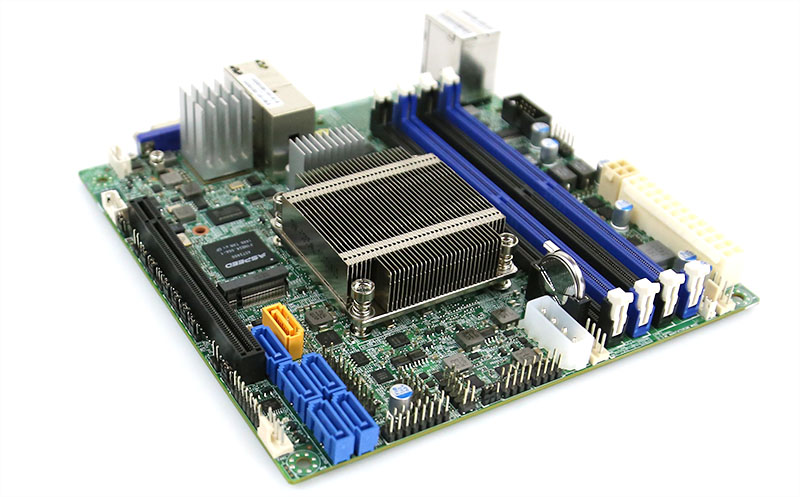
Overall, this is a very high end configuration that we will use for parity with the Xeon D-1540 benchmarking.
Intel Xeon D-1520 Benchmarks Performance
Four our testing we are using Linux-Bench scripts which help us see cross platform “least common denominator” results. We are using gcc due to its ubiquity as a default compiler. One can see details of each benchmark here. If you want to see an example run, you can find an example on the beta site here.
c-ray 1.1 Performance
We have been using c-ray for our performance testing for years now. It is a ray tracing benchmark that is extremely popular to show differences in processors.
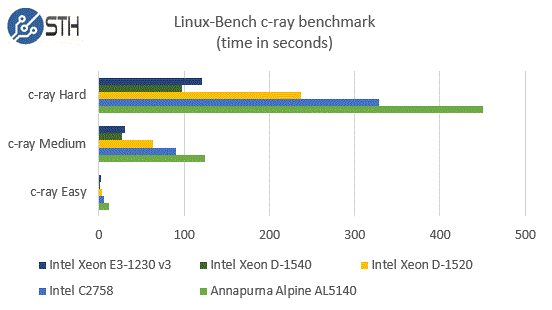
Here we can see what will be the theme of the day. We are even including our latest Annapurna Labs Alpine AL5140 ARM based CPU in the mix. Even with its 8 cores, one can see the Intel Atom C2758 pale in performance to the D-1520. The Xeon E3-1230 V3 benefits from the same number of cores but at higher clock speeds.
7zip Performance
7zip is a widely used compression/ decompression program that works cross platform. We started using the program during our early days with Windows testing. It is now part of Linux-Bench.
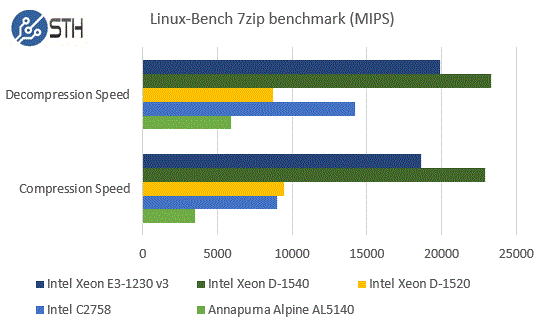
As we look at compression, we were a bit surprised at the results. We expected the Xeon D-1520 to have higher decompression speeds. We did make results for four of our Xeon D-1520 runs public on the Linux-Bench beta site and the results across our 10 runs we used were very consistent.
Redis Performance
Redis is a popular in-memory key value store meant to make large web applications scale. It is s highly memory speed dependent benchmark.
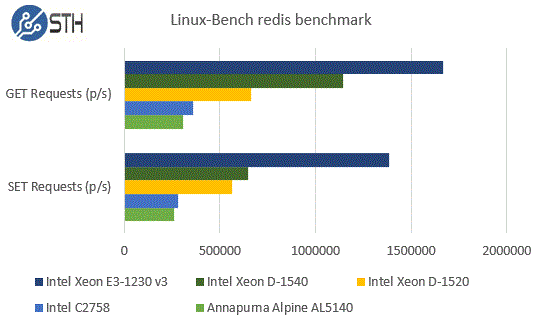
Our resdis results were very close between the D-1540 and D-1520 n the SET Requests side. On the GET requests we saw the D-1540 pull away. The Intel Xeon E3-1230 v3 performs extremely well on this benchmark.
STREAM Performance
STREAM is perhaps the seminal memory bandwidth application used for well over a decade. The benchmark was created and is maintained by Dr. John D. McCalpin. Essential can be found here.
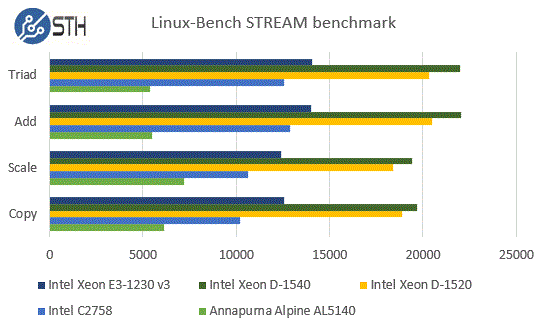
Somewhat surprisingly, we saw slightly lower memory bandwidth on the Intel Xeon D-1520 v. D-1540. Still, one can see the impact of the DDR4 RAM on performance versus the DDR3 competition.
OpenSSL Performance
OpenSSL is widely used to secure communications between servers. This is an important protocol in some storage stacks. We first look at our sign tests:
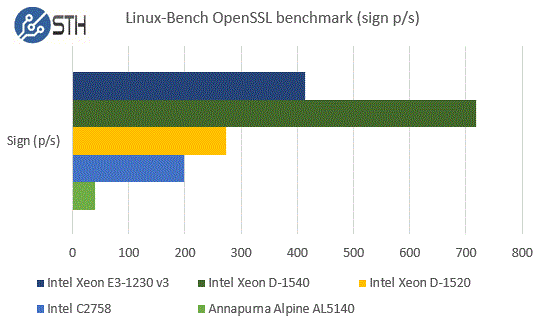
Losing half its cores still puts the D-1520 ahead of the C2758, however it has middle of the pack performance in our comparison group. Moving to the verify results:
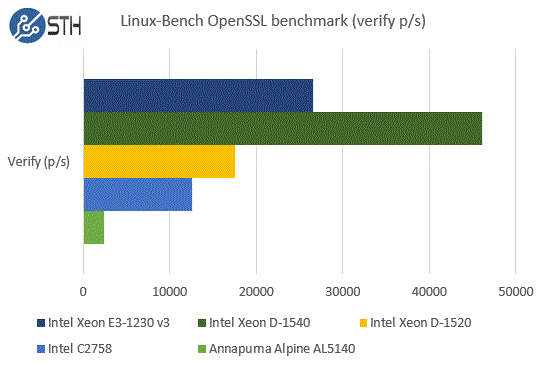
Overall, one can see a similar trend develop on the OpenSSL verify side. We were surprised overall that our D-1520 was not getting a full 1/2 the performance of the D-1540.
UnixBench Dhrystone 2 and Whetstone Benchmarks
Of course, these chips are not meant for heavy compute but we pick out the UnixBench 5.1.3 Dhrystone 2 and Whetstone results.
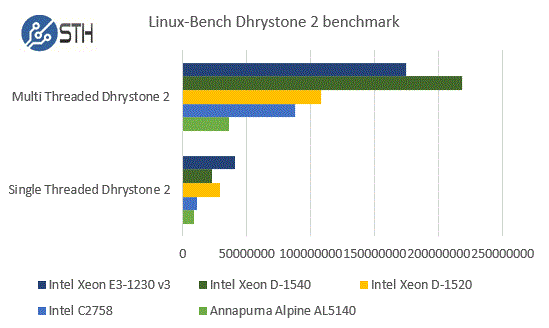
Here we do see the scaling we would expect. The Single Threaded Dhrystone 2 results show the single processor performance of the Xeon D-1520 being slightly higher as we might expect with the slightly higher base clock.
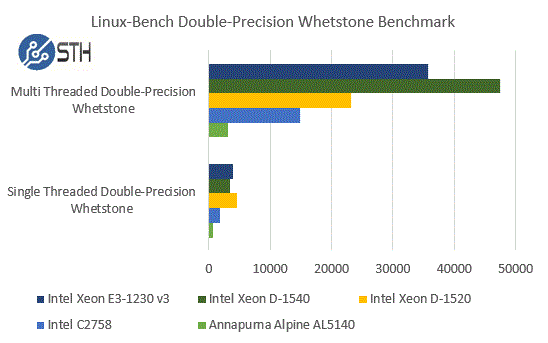
On the floating point side we see a similar trend. Interestingly enough, the Xeon D-1520 did score a win on the single threaded tests here.
hardinfo Benchmark Summary
Perhaps some of the most standard benchmarks that come along with many versions of Ubuntu, the hardinfo suite has been a mainstay at STH. Since the patterns we have seen above are repetitive in the hardinfo results, we are going to post these as an entire set.
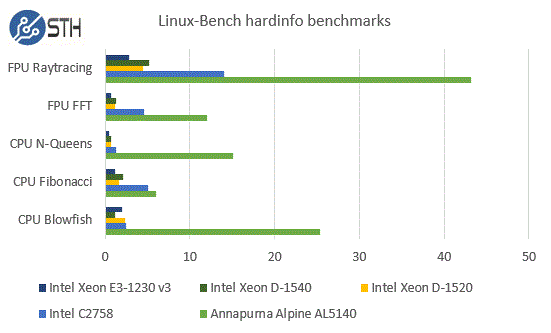
Here is the summary: the Annapurna Labs chip has dual 10Gb Ethernet, like the Xeon D-1520. The Annapurna Labs chip has 10x more SATA ports but fewer PCIe lanes and lower memory capacity. Intel is selling the Xeon D-1520 for $199 and does not require porting software to ARM which can be painful. This Xeon D-1520 is a low end monster.
Conclusion
It is a bit unfair of a comparison. The Atom C2000 line we also had first benchmarks of back in October 2013 and is due for a refresh. The Xeon D-1540 costs more than 2x as much. The Xeon E3-1230 v3 (since nobody is really using v4 for CPU compute) is getting replaced by Skylake soon. But as of right now, the $300-400 lower platforms with the Intel Xeon D-1520 will be priced at is a huge benefit. Whereas many of the ARM vendors tout RDIMM support, 10GbE and Atom C2750/ C2758 competitive performance, Intel delivered the silicon, at a $199 price point. Where are the AppliedMicro X-Gene chips? Where are the AMD Opteron A1100 series chips that got a lot of press a year ago? Given, we had to wait for almost 5 months just to get the D-1520, but Intel is purposefully delaying the launch of the Xeon D series variants. We have heard from sources that we will see more variants including 25w TDP and market specialized (e.g. network and storage) SKUs by the end of the year, but Intel has been selling the D-1540 so fast that not many vendors can even secure a supply.
Now for the flip side: D-1520 or D-1540. If you are going for a low-end configuration, the D-1520 makes sense. If you are adding 64GB-128GB of RAM ($600- $1800), NVMe SSDs and/ or large SATA SSDs ($600-$3000) the extra $300-400 for the D-1540 makes sense. If you are looking for a low power system with 10Gb Ethernet and are more CPU bound rather than RAM bound, then the D-1520 will make sense to save on each node. We will have a formal review of the Supermicro X10SDV-4C-TLN2F soon, but suffice to say that getting a CPU, motherboard and dual 10Gbase-T Ethernet in the ~$450 price range is going to be the must-get platform for many applications where RAM, disk and network throughput matter more than raw CPU core counts. The test board we have already has 2x 1TB SATA SSDs and a NVMe SSD installed with 64GB of RAM for a converged hypervisor/ Ceph storage node and it is working very well. The possibilities with the lower cost D-1520 are awesome and they hint at the complete transformation we saw kicked off with the D-1540 brought down to a more affordable price point with the D-1520.





You guys are f*ing awesome. I can’t wait to be able to buy these boards. I don’t need the 8c part so this is perfect for what we are building. Thankx StH
Will be interesting to see how many use this as a more budget-friendly homelab board.
hi Patrick, very nice review ! the only one I could find on D-1520.
My dedicated server provider is offering servers with D-1520 (here: https://www.ovh.com/us/dedicated-servers/hosting/ );
I have at the moment a dedicated with a core i5 2400 with 16 GB DDR3 ram.
How would that compare with the D-1520 just in terms of raw power (say cpu passmark rating); the D-1540 has about 9000-10 000 points against 5000 for the core i5) ? (use is for flash streaming, and some video transcoding)
Thanks !
If you can use the integrated GPU for transcoding (Quick Sync) I might be inclined to keep the i5-2400. Clock for clock the D-1520 is faster but the i5 you mention has much higher clock speeds. You do get more threads due to Hyper-Threading which is good for some transcoding applications. Some others do not work as well with Hyper-Threading. Best to check your actual applications to see if they can use HT and/ or an integrated GPU.
ok thanks a lot Patrick, that’s very helpful. I’m considering going to the D-1540 in that case since there won’t be any question this is better.
You’re the man ! :)
follow-up: at last, there is now one passmark score for the D-1520; it scores at 6400 against 5825 for a core i5 2400, so it’s 10% stronger in that benchmark.
Hi Patrick, I’m trying to find information on whether or not the Xeon-D platform support LRDIMM or not. You have stated that you have tested with 4x32GB LRDIMM, but I do not find any info on this in SuperMicro’s datasheets or manuals.
http://www.supermicro.com/products/motherboard/xeon/d/X10SDV-4C-TLN2F.cfm
Is it as simple as LRDIMM being compatible with RDIMM?